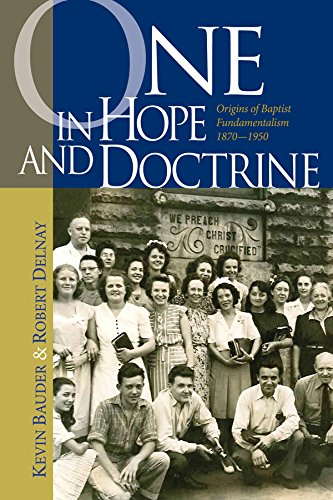I am always interested in new books about the Baptist Fundamentalism. I heard about this book a few years ago but only recently purchased it. The reason I delayed buying it was that it has remained fairly expensive and I had not found a copy at a price I was willing to pay.
One in Hope and Doctrine: Origins of Baptist Fundamentalism 1870-1950 is co-written by Kevin Bauder and Robert Delaney and was published by the Regular Baptist Press in 2014. It is only available in paperback I believe and is 396 pages.
My first criticism is the title does not match the content of the book. It should be titled Origins of the GARBC (General Association of Regular Baptists Churches). It excels in telling the story of the origins and early days of the GARBC. As someone who has studied far more about Southern Fundamentalist movements I found that information well done. However, this book does not fairly or adequately cover any movements that did not lead to the GARBC or arise from Northern Baptist heritage.
My second criticism is the authors show little or no objectivity in dealing with Southern Fundamentalism. These authors have an obvious axe to grind against Southern Fundamentalism and its leaders. J. Frank Norris is treated as an inhuman and immoral monster and John R. Rice is treated as a closet Pentecostal. If there is a chance to take a jab at Norris it is swung with gusto even if it has little or no bearing on the actual focus of the book. He is the villain of this story.
Admittedly Norris did bring much of this criticism on himself. He tried to join the GARBC and probably would have attempted to absorb it into his own sphere. He attacked Ketchum and others in print and private. While Ketchum chose not to respond, these authors have chosen to fire multiple broadsides in response. The bias and vitriol is overwhelming for a book supposedly written by academics as a serious historical study.
Some proofs of this unnecessary bias include:
- In the Index you will find that there are more references to J. Frank Norris than any other individual. More than Ketchum, Van Osdel, Riley. You will also notice that John R. Rice (who really had little to do GARBC) has about as many references as W.B. Riley (who had a lot to do with GARBC’s history). Why are Norris and Rice mentioned so much when the narrative is supposedly about a group they had very little to do with?
- Beginning on page 313 and lasting 16 pages, there is an absolutely unnecessary section dealing with controversies with John R. Rice. The first is an overblown dispute between Rice and Lewis Sperry Chafer on the role of an evangelist. The second is a critical review of Rice’s positions in his book The Power of Pentecost. Neither of these add anything to the narrative other than to glorify the author’s own movement and vilify Rice (and by extension Southern Fundamentalism). When one of the few GARBC controversies (women preachers) is addressed, it is covered with only seven pages beginning on page 199.
- The use of unprofessional, unacademic, biased language. On page 253, Norris is described as acting “like a jilted teenager”. On page 258, the structure of the GARBC executive committee is described as “sheer genius”.
We can debate the actions of Norris and the positions of Rice and I have no issue doing so. What I take issue with is a book that proports to be a serious historical study yet constantly descends into petty partisan propaganda.
Related to this criticism, I find the section from pages 295-301 to be curious. It is an analysis of Southern Fundamentalism based on the thoughts of Jack Hyles. While every opportunity is taken to attack Norris and Rice, the authors are strangely silent about the accusations and legacy of Jack Hyles. While Hyles’ observations are interesting, their inclusion without comment on their source highlights how unfairly this book treats other Southern Fundamentalists.
My third criticism is that the writers arrogantly assume their own movement to be true Fundamentalism. From the title to the declaration on page 380 that “Thus ends this first part of the story of Baptist fundamentalism” there is a misguided attempt to make the GARBC movement to be the one true bastion of historic fundamentalism. Other movements are criticized, downplayed, or ignored. This book is more propaganda and claptrap for the GARBC than an honest history survey.
What is this book? It does not live up to its title in scope. It covers the origins and precursors of GARBC and other Northern Baptists Fundamentalists well. It is very unbalanced in how it treats Southern Fundamentalists.
Oliver Van Osdel appears is finally receiving the recognition he deserves. Robert Ketcham is presented as the “Great Man” of the movement despite such a philosophy being criticized on page 300. The interaction of Norris with the GARBC is inflated I think to manufacture a villain for the narrative. The coverage of Rice is unnecessary and barely fits the focus of the book.
In my opinion, this book should be edited into two separate works. The first, a scholastic history of Northern Baptist Fundamentalism and the GARBC. The second, an editorial work criticizing Southern Fundamentalism and its leaders. Both would be of value separately, but combined it makes for an uneven narrative told with inconsistent voice.
Students of the history of Fundamentalism deserve better.
